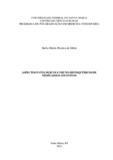| dc.creator | Melo, Stella Maris Pereira de | |
| dc.date.accessioned | 2021-07-01T17:45:54Z | |
| dc.date.available | 2021-07-01T17:45:54Z | |
| dc.date.issued | 2021-02-12 | |
| dc.identifier.uri | http://repositorio.ufsm.br/handle/1/21288 | |
| dc.description.abstract | Neoplasms in sheep are uncommon, and the prevalence of different histological subtypes of
tumours can vary widely between different geographic regions. In the literature, there are few
characterization studies that investigate the prevalence, and detail the pathological and
immunohistochemical aspects of neoplastic diseases in this species. Thus, the objective of this
study was to determine the prevalence of neoplasms in sheep at the Veterinary Pathology
Laboratory (LPV) of the Federal University of Santa Maria (UFSM), for 40 years (1980-2019),
and to characterize its macroscopic, histopathological, and immunohistochemical aspects.
Information regarding the profile of the animals (age, breed, and sex), clinical, macroscopic
and histological changes were collected from the necropsy reports and histopathological exams
with diagnosis of neoplasms. During this period, of a total of 1,945 exams performed, 35 sheep
(1.8%) were affected by neoplasms, the majority being classified as malignant (30/35). In
general, the most prevalent tumour was squamous cell carcinoma (17/35) and mainly affected
the integumentary system (10/17). Other types of neoplasms occurred less frequently, affecting
different organ systems and comprised, in decreasing order: lymphoma (7/35), intestinal
adenocarcinoma (3/35), fibroma (3/35), hepatocellular carcinoma (1/35), cholangiocarcinoma
(1/35), fibrosarcoma (1/35), papilloma (1/35) and ruminal fibropapilloma (1/35).
Histologically, neoplasms of epithelial origin were characterized by cubic or polyhedral cells
arranged in islands, ribbons, cords, nests, acini or ducts. Tumours of mesenchymal origin or of
round cells, presented spindle or round cells arranged in bundles or in mantle. Some histological
types, such as cholangiocarcinoma and fibrosarcoma, showed particularly unusual macroscopic
and histological changes in this case series. The immunohistochemistry technique was
performed mainly on malignant tumours and allowed to determine the origin of the neoplastic
cells in some cases, which helped to confirm the diagnosis. Through this study, it was possible
to know the prevalence of neoplasms in sheep in the routine of a veterinary pathology laboratory
in 40 years of diagnosis. The study also made it possible to characterize the
anatomopathological and immunohistochemical aspects of these neoplasms, providing new and
relevant information for the diagnosis of neoplasms in the sheep species. | eng |
| dc.description.sponsorship | Coordenação de Aperfeiçoamento de Pessoal de Nível Superior - CAPES | por |
| dc.description.sponsorship | Conselho Nacional de Pesquisa e Desenvolvimento Científico e Tecnológico - CNPq | por |
| dc.language | por | por |
| dc.publisher | Universidade Federal de Santa Maria | por |
| dc.rights | Attribution-NonCommercial-NoDerivatives 4.0 International | * |
| dc.rights.uri | http://creativecommons.org/licenses/by-nc-nd/4.0/ | * |
| dc.subject | Ruminante | por |
| dc.subject | Tumor | por |
| dc.subject | Necropsia | por |
| dc.subject | Histopatologia | por |
| dc.subject | Doenças de ovinos | por |
| dc.subject | Ruminant | eng |
| dc.subject | Tumour | eng |
| dc.subject | Necropsy | eng |
| dc.subject | Histopathology | eng |
| dc.subject | Sheep diseases | eng |
| dc.title | Aspectos patológicos e imuno-histoquímicos de neoplasmas em ovinos | por |
| dc.title.alternative | Pathological and immunohistochemical aspects of neoplasms in sheep | eng |
| dc.type | Dissertação | por |
| dc.description.resumo | Neoplasmas em ovinos são infrequentes, e a prevalência dos diferentes subtipos histológicos
de tumores pode variar bastante entre as diferentes regiões geográficas. Na literatura, há poucos
estudos de caracterização que investiguem a prevalência e detalhem os aspectos patológicos e
imuno-histoquímicos das doenças neoplásicas nesta espécie. Desta forma, o objetivo deste
estudo foi determinar a prevalência de neoplasmas em ovinos no Laboratório de Patologia
Veterinária (LPV) da Universidade Federal de Santa Maria (UFSM), durante 40 anos (1980-
2019) e caracterizar os seus aspectos macroscópicos, histopatológicos e imuno-histoquímicos.
Informações referentes ao perfil dos animais (idade, raça e sexo), alterações clínicas,
macroscópicas e histológicas foram coletadas dos laudos de necropsias e exames
histopatológicos com diagnóstico de neoplasias. Durante este período, 35 ovinos (1,8%) foram
acometidos por neoplasmas, sendo a maioria classificados como malignos (30/35). Em geral, o
tumor mais prevalente foi o carcinoma de células escamosas (17/35) e afetou principalmente o
sistema tegumentar (10/17). Outros tipos de neoplasmas ocorreram menos frequentemente,
afetando diferentes sistemas orgânicos e compreenderam em ordem decrescente: linfoma
(7/35), adenocarcinoma intestinal (3/35), fibroma (3/35), carcinoma hepatocelular (1/35),
colangiocarcinoma (1/35), fibrossarcoma (1/35), papiloma (1/35) e fibropapiloma ruminal
(1/35). Na histologia, os neoplasmas de origem epitelial se caracterizaram por células cúbicas
ou poliédricas arranjadas em ilhas, fitas, cordões, ninhos, ácinos ou ductos. Tumores de origem
mesenquimal ou de células redondas apresentaram células fusiformes ou redondas dispostas em
feixes ou em manto. Alguns tipos histológicos, como o colangiocarcinoma e o fibrossarcoma,
apresentaram alterações macroscópicas e histológicas particularmente incomuns. A técnica de
imuno-histoquímica foi realizada principalmente em tumores malignos e permitiu determinar a
origem das células neoplásicas em alguns casos, o que auxiliou na confirmação do diagnóstico.
Por meio desse estudo, foi possível conhecer a prevalência de neoplasias em ovinos na rotina
de um laboratório de patologia veterinária em 40 anos de diagnóstico. O estudo também
permitiu caracterizar os aspectos anatomopatológicos e imuno-histoquímicos desses
neoplasmas, fornecendo informações novas e relevantes para o diagnóstico de neoplasias na
espécie ovina. | por |
| dc.contributor.advisor1 | Kommers, Glaucia Denise | |
| dc.contributor.advisor1Lattes | http://lattes.cnpq.br/5818649889964582 | por |
| dc.contributor.referee1 | Fernandes, Cristina Gevehr | |
| dc.contributor.referee2 | Flores, Mariana Martins | |
| dc.creator.Lattes | http://lattes.cnpq.br/2504461354124821 | por |
| dc.publisher.country | Brasil | por |
| dc.publisher.department | Medicina Veterinária | por |
| dc.publisher.initials | UFSM | por |
| dc.publisher.program | Programa de Pós-Graduação em Medicina Veterinária | por |
| dc.subject.cnpq | CNPQ::CIENCIAS AGRARIAS::MEDICINA VETERINARIA | por |
| dc.publisher.unidade | Centro de Ciências Rurais | por |



